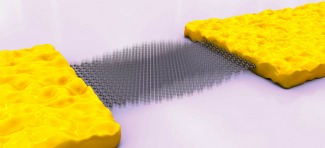Exotic behaviour when mechanical devices reach the nanoscale

In an article to be published in Nature Nanotechnology, Prof. Bachtold and his co‐researchers describe how they formed nano‐scale resonators by suspending tiny graphene sheets or carbon nanotubes and clamping them at each end. These devices, similar to guitar strings, can be set to vibrate at very specific frequencies.
In all mechanical resonators studied to date, from large objects several metres in size down to tiny components just a few tens of nanometers in length, damping has always been observed to occur in a highly predictable, linear manner. However Prof. Bachtold´s research demonstrates that this linear damping paradigm breaks down for resonators with critical dimensions on the atomic scale. Of particular importance they have shown that the damping is strongly nonlinear for resonators based on
nanotubes and graphene, a characteristic that facilitates amplification of signals and dramatic improvements in sensitivity.
The finding has profound consequences. Damping is central to the physics of nanoelectromechanical resonators, lying at the core of quantum and sensing experiments. Therefore many predictions that have been made for nanoscale electro‐mechanical devices now need to be revisited when considering nanotube and graphene resonators.
This new insight into the dynamics of nano‐scale resonators will also enable dramatic improvements in the performance of numerous devices. Already the Prof. Bachtold´s group has achieved a new record in quality factor for graphene resonators and ultra‐weak force sensing with a nanotube resonator.
The work is particularly timely because an increasing number of research groups around the world with diverse backgrounds are choosing to study nanotube/graphene resonators, which have a number of uniquely useful properties.
References
“Nonlinear damping in mechanical resonators made from carbon nanotubes and graphene", Nature Nanotechnology, DOI ‐10.1038/NNANO.2011.71


